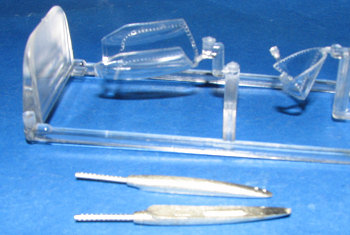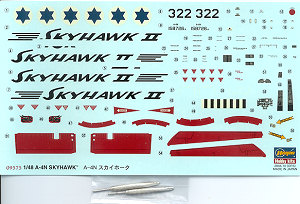
| KIT: | Hasegawa 1/48 A-4N Skyhawk |
| KIT #: | 09575 |
| PRICE: | 2800 yen MSRP, but often cheaper from show vendors |
| DECALS: | Many Options |
| REVIEWER: | Scott Van Aken |
| NOTES: | Cast metal 30mm guns |

| HISTORY |
The Skyhawk was designed by Douglas' Ed Heinemann in response to a U.S. Navy call for a jet-powered attack aircraft to replace the A-1 Skyraider. Heinemann opted for a design that would minimize size, weight, and complexity. The result was an aircraft that weighed only half of the Navy's specification and had a wing so compact that it did not need to be folded for carrier stowage. The diminutive Skyhawk soon received the nicknames "Scooter", "Bantam Bomber", "Tinker Toy Bomber", and, on account of its nimble performance, "Heinemann's Hot-Rod."
The Navy issued a contract for the type on June 12 1952, and the first prototype first flew on June 22, 1954. Deliveries to Navy and U.S. Marine Corps squadrons commenced in late 1956.
The Skyhawk remained in production until 1979, with a total of 2,960 aircraft built, including 555 two-seat trainers. The US Navy began removing the aircraft from its front-line squadrons in 1967, with the last retiring in 1975. The Marines would pass on the Navy's replacement, the A-7 Corsair II, instead keeping Skyhawks in service, and ordering the new A-4M. The last USMC Skyhawk was delivered in 1979, and were used until the mid-1980s until they were replaced by the similarly small, but STOVL AV-8 Harrier II.
The Diamondbacks of VMA-131,Marine Aircraft Group 49 retired their last four A-4Ms on June 22,1994. LtCol. George "Eagle" Lake III (CO), Major John "Baja" Rufo (XO), Captain Dave "Yoda" Hurston and Major Mike "Struts" Volland flew a final official USMC A-4 sortie during the A-4 Standdown Ceremony. Trainer versions of the Skyhawk remained in Navy service, however, finding a new lease on life with the advent of adversary training, where the nimble A-4 was used as a stand-in for the Mikoyan-Gurevich MiG-17 in dissimilar air combat training (DACT). It served in that role until 1999, when the last were replaced with the T-45 Goshawk. The A-4's nimble performance also made it suitable to replace the F-4 Phantom II when the services downsized their aircraft for the Blue Angels demonstration team, popularized on a 80s rock video, until the availability of the F/A-18 Hornet in the 1980s. The last US Navy Skyhawks, TA-4J models belonging to composite squadron VC-8, remained in military use for target-towing and as adversary aircraft for combat training at Naval Air Station Roosevelt Roads. They were officially retired on May 3, 2003.
The Skyhawk proved to be one of the most popular US naval aircraft exports of the postwar era. Due to its small size, it could be operated from the older, smaller World War II-era aircraft carriers still used by many smaller navies during the 1960s. These older ships were often unable to accommodate newer USN fighters such as the F-4 Phantom II and F-8 Crusader, which were faster and more capable than the A-4, but significantly larger and heavier than older naval fighters.
The biggest overseas user of the Skyhawk was the Israeli Air Force. First taking delivery of A-4H versions in 1966 (basically an A-4F without the avionics hump), these were up-gunned with 30mm cannon and had a 'squared off' fin tip. 90 airframes were eventually orders. After losses during the Yom Kippur War in 1973, attrition replacements were sent, these also being modified, bringing the total number to 136 airframes.
So much did the Israeli's like the aircraft that they also ordered the upgraded A-4M, designating the aircraft the A-4N. As with the A-4H, these aircraft had Israeli avionics and the 20mm cannon replaced with 30mm versions. These 117 aircraft soldiered on for many years, and when retired from service, like the earlier A-4Hs, many were sold overseas.
| THE KIT |
 Hasegawa's
excellent A-4 series of kits have been around for quite a number of years and
are the darlings of the Skyhawk fan. There have been a number of different
boxings, but all have based on the same general sprues. Not all versions can be
built from the base sprues as Hasegawa tends to remove any bits that make that
possible. However, if you have seen one set of Hasegawa A-4 sprues, you have
basically seen them all.
Hasegawa's
excellent A-4 series of kits have been around for quite a number of years and
are the darlings of the Skyhawk fan. There have been a number of different
boxings, but all have based on the same general sprues. Not all versions can be
built from the base sprues as Hasegawa tends to remove any bits that make that
possible. However, if you have seen one set of Hasegawa A-4 sprues, you have
basically seen them all.
The only really different bits in this kit are the A-4M
canopy and a pair of cast metal 30mm cannon. these cannon are superbly molded
and with just a touch of clean-up, will be ready to insert into the shell
ejection chutes of the M k it. All
the other bits are just what you'd get with the A-4M boxing. Yes, my photo
sucks, but it does show the guns and M canopy.
it. All
the other bits are just what you'd get with the A-4M boxing. Yes, my photo
sucks, but it does show the guns and M canopy.
Besides these parts, you get a decal sheet that is unique to this boxing. Since the markings are basically boring, Hasegawa has chosen to offer the red warning areas around the intake, the inside of the flaps, and the inside of the slats as decals. The other marks are Skyhawk II introduction decals and one set of markings for 115 'Flying Dragon' squadron. I'd like to think that IsraDecal has a sheet for this, but they seem to have stopped sending in review materials, so I don't know if they do or not. The kit decals are the old type that are a bit thick and have white that is a bit on the ivory side. Use setting solutions at your own peril.
| CONCLUSIONS |
OK, a very nice later model Israeli Skyhawk for those who have to have one. It is nicely detailed and despite having what I think are dull markings options, the nice camo scheme carried by these aircraft should help to off-set that.
March 2007
Thanks to me and my acute 'deal' senses when fishing this out of a pile from a vendor's table.
If you would like your product reviewed fairly and fairly quickly by a site that has over 350,000 visitors a month, please contact me or see other details in the Note to Contributors.